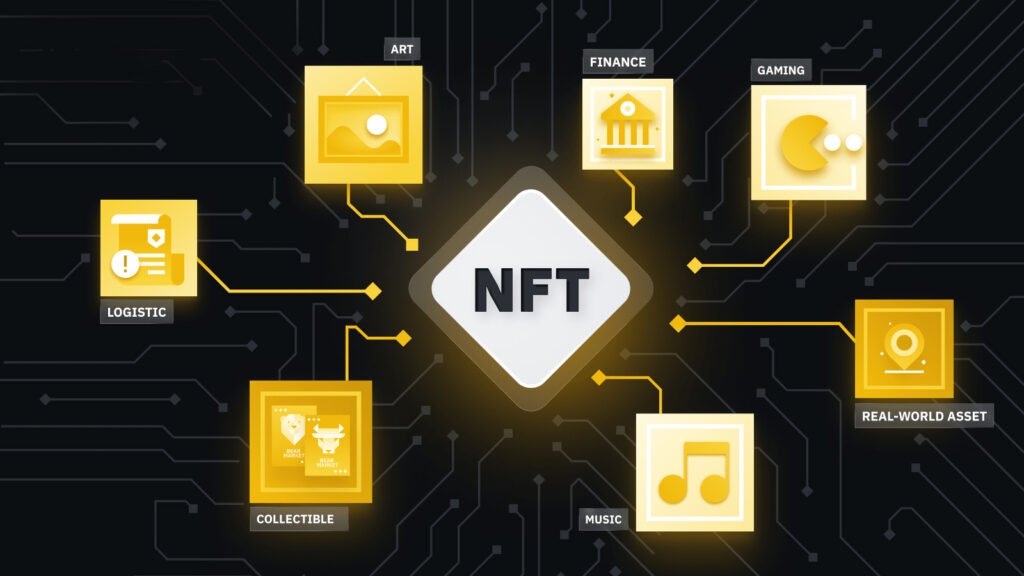The Role of NFTs in the Crypto Ecosystem: More Than Just Art?
Non-Fungible Tokens (NFTs) have captured widespread attention, primarily through high-profile art sales and digital collectibles. However, the role of NFTs extends far beyond the art world, impacting various aspects of the crypto ecosystem. This exploration delves into the multifaceted roles of NFTs, highlighting their potential to revolutionize multiple industries.

Understanding NFTs
NFTs are unique digital assets verified using blockchain technology, ensuring their authenticity and ownership. Unlike cryptocurrencies such as Bitcoin or Ethereum, which are fungible and can be exchanged on a one-to-one basis, NFTs are indivisible and unique, making them suitable for representing individual assets.
Beyond Art: The Expanding Applications of NFTs
Digital Identity and Ownership
NFTs provide a secure and verifiable method for managing digital identity and ownership. They can represent ownership of various digital assets, including virtual real estate, domain names, and digital certificates. For instance, Decentraland uses NFTs to represent ownership of virtual land parcels, allowing users to buy, sell, and develop digital real estate.
Gaming and Virtual Goods
The gaming industry has embraced NFTs for representing in-game assets like weapons, skins, and characters. Unlike traditional in-game purchases, NFTs allow players to own, trade, and monetize their virtual assets outside the game’s ecosystem. Games like Axie Infinity and The Sandbox use NFTs to create vibrant virtual economies, where players can earn real income.
Intellectual Property and Licensing
NFTs offer a new paradigm for managing intellectual property (IP) and licensing. Creators can tokenize their work, providing a transparent and secure way to track and enforce IP rights. Musicians, authors, and filmmakers can use NFTs to sell rights to their work, ensuring they receive royalties each time the asset is sold or used.
Supply Chain and Provenance
In industries like luxury goods, food, and pharmaceuticals, NFTs can ensure product authenticity and traceability. By attaching NFTs to physical products, companies can create an immutable record of the product’s journey through the supply chain, helping to combat counterfeiting and ensure quality.
Event Tickets and Membership
NFTs can revolutionize event ticketing and membership programs by providing a secure, tamper-proof solution. Event organizers can issue NFT-based tickets that eliminate fraud and scalping. These tickets can also serve as collectibles or provide ongoing benefits, such as exclusive content or access to future events.
NFTs and Decentralized Finance (DeFi)
NFTs are increasingly intersecting with DeFi, creating new financial products and opportunities. Platforms are emerging where NFTs can be used as collateral for loans, enabling users to leverage their digital assets for liquidity without selling them. Additionally, NFT staking allows users to earn rewards by locking up their NFTs in decentralized protocols.
Challenges and Considerations
While NFTs offer numerous possibilities, they also present challenges and considerations that need addressing for widespread adoption.
Environmental Impact
The energy-intensive nature of blockchain networks, particularly those using proof-of-work (PoW) consensus mechanisms, raises environmental concerns. However, the transition to proof-of-stake (PoS) networks and layer 2 solutions promises to mitigate these issues by reducing energy consumption.
Legal and Regulatory Issues
The legal status of NFTs is still evolving, with questions surrounding intellectual property rights, securities regulations, and taxation. Clear regulatory frameworks are essential to protect creators and consumers while fostering innovation.
Market Volatility and Speculation
The NFT market is highly volatile, with prices often driven by speculation. This can lead to significant financial risk for investors and creators. A sustainable market requires a focus on utility and long-term value rather than short-term hype.
The Future of NFTs
The future of NFTs lies in their integration across various sectors, providing unique solutions and enhancing digital experiences. Innovations in blockchain technology, such as improved scalability and interoperability, will further drive NFT adoption.
Cross-Chain Compatibility
Interoperability between different blockchain networks will enable seamless transfer and use of NFTs across platforms. Projects like Polkadot and Cosmos are working towards creating interconnected blockchain ecosystems that support NFT interoperability.
Enhanced Utility and Functionality
Future developments will likely focus on enhancing the utility and functionality of NFTs. This includes dynamic NFTs that can change based on certain conditions, fractional ownership allowing multiple stakeholders, and more sophisticated smart contracts enabling complex interactions.
Conclusion
NFTs are more than just digital art; they represent a transformative force in the crypto ecosystem. Their applications span various industries, from gaming and digital identity to supply chain management and DeFi. While challenges remain, the continued evolution of blockchain technology and regulatory clarity will pave the way for broader adoption and innovative uses of NFTs. As the ecosystem matures, NFTs will play a critical role in shaping the future of digital ownership and the decentralized economy.